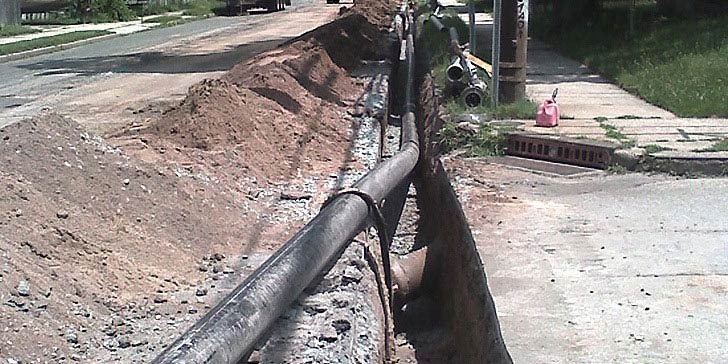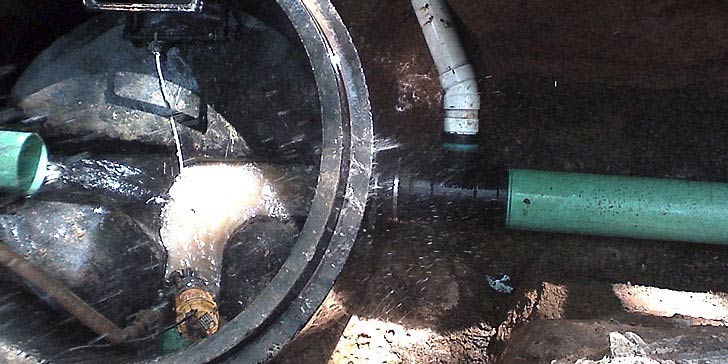We Offer Free Video Inspections!
ICUNJ has led the industry in implementing innovative solutions. No two
projects are the same, so our dedicated team of industry experts work
with you to develop customized solutions to meet the most
challenging conditions.
Cured In Place Pipe (CIPP) Lining:
A cured-in-place pipe (CIPP) is one of several trenchless rehabilitation methods used to repair existing pipelines. CIPP is a jointless, seamless, pipe-within-a-pipe with the capability to rehabilitate pipes ranging in diameter from 0.1–2.8 meter (4"–110"). As one of the most widely used rehabilitation methods CIPP has application in water, sewer, gas, and chemical pipelines.
A resin-saturated felt tube made of polyester is inverted or pulled into a damaged pipe. It is usually done from the upstream access point (manhole or excavation). It is possible to invert the liner upstream (e.g. from the downstream access point) but this carries greater risk. It is possible to install a liner from the downstream access point, upstream to a blind end however this carried the highest risk of all the CIPP installation methodologies. Little to no digging is involved in this trenchless process, making for a more environmentally friendly method than traditional "dig and replace" pipe repair methods. The liner can be inverted using water or air pressure. The pressure required for inversion can be generated using pressure vessels, scaffolds or a "Chip unit". Hot water, UV light, ambient cured or steam is used to cure the resin and form a tight-fitting, jointless and corrosion-resistant replacement pipe. Service laterals are restored internally with robotically controlled cutting devices. These can be sealed with additional seals into the lateral connection (Lateral Junction Repair). The rehabilitated pipe is then inspected by closed-circuit television (CCTV). CIPP is considered a trenchless technology.
Advantages: Typically, trenchless technology, CIPP does not require excavation to rehabilitate a pipeline that is either leaking or structurally unsound. Depending upon design considerations an excavation may be made, but the liner is often installed through a manhole, cleanout or other existing access point. Larger Diameter liners must be excavated in order to install. Liner is installed as it is wet out on site in these instances. In the case of sewer lines, lateral connections are also restored without excavation via a remote controlled device that drills a hole in the liner at the point of the lateral connection. CIPP has a smooth interior and no joints. While CIPP can repair a pipe with bends, special design considerations must be taken into account to prevent wrinkling and stretching. CIPP can effectively reduce infiltration and leaks in pipeline systems without digging.
Disadvantages: Except for very common sizes, liners are not usually stocked and must be made specifically for each project. CIPP requires bypass of the flow in the existing pipeline while the liner is being installed. The curing may take from five hours to 30 hours depending on pipe diameter and must be carefully monitored, inspected, and tested. Obstructions in the existing pipeline, such as protruding laterals, must be removed prior to installation. CIPP must also be carefully monitored for release of chemical agents utilized in the reaction process for contamination downstream of rehabilitated pipes. The liner material used for common sizes is normally a felted fabric (weave) and does not go around bends well without wrinkling and going out of round on corners. Liners used for pipes with bends (particularly 100 mm pipes) are made from a woven fabric allowing it to go around bends with minimal wrinkling. The more flexible the liner, the more care needs to be taken during inversion to ensure the liner remains on the correct alignment. All liners travel along the existing pipe alignment. If the existing pipe has a sag/belly, offset joint, collapsed section or other obstruction, the new liner will mirror the condition –lining is not recommended for pipe with these conditions. In addition, liners reduce the inside diameter of pipe which may affect pipe performance.
Preventive measures list:
»Replace old pipes before problems occur
»Request camera inspection of main sewerline when purchasing property.
»Scheduling regular pipe inspections and cleaning
Methods to Eliminate Defects in Sewers
Pipe Bursting: Cured In Place Pipe (CIPP) lining:
Open Cut Construction Spot Repairs High Pressure Jetting Snaking





